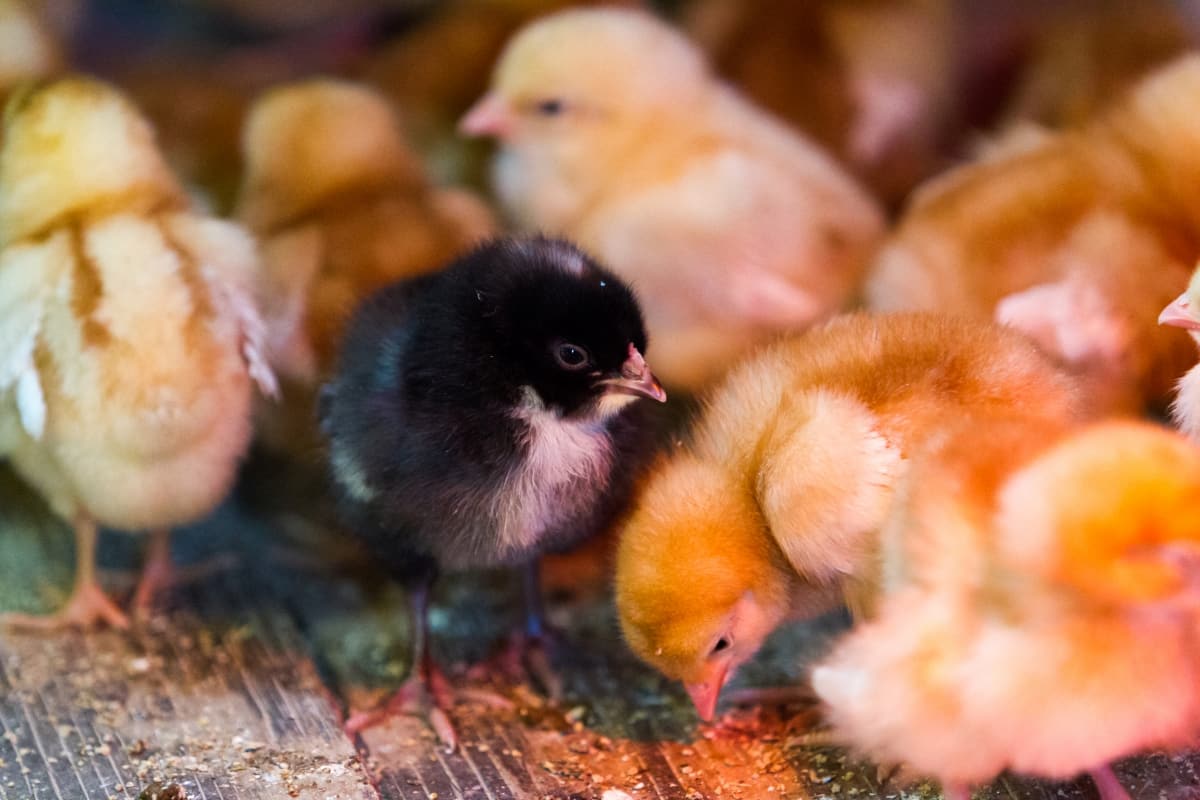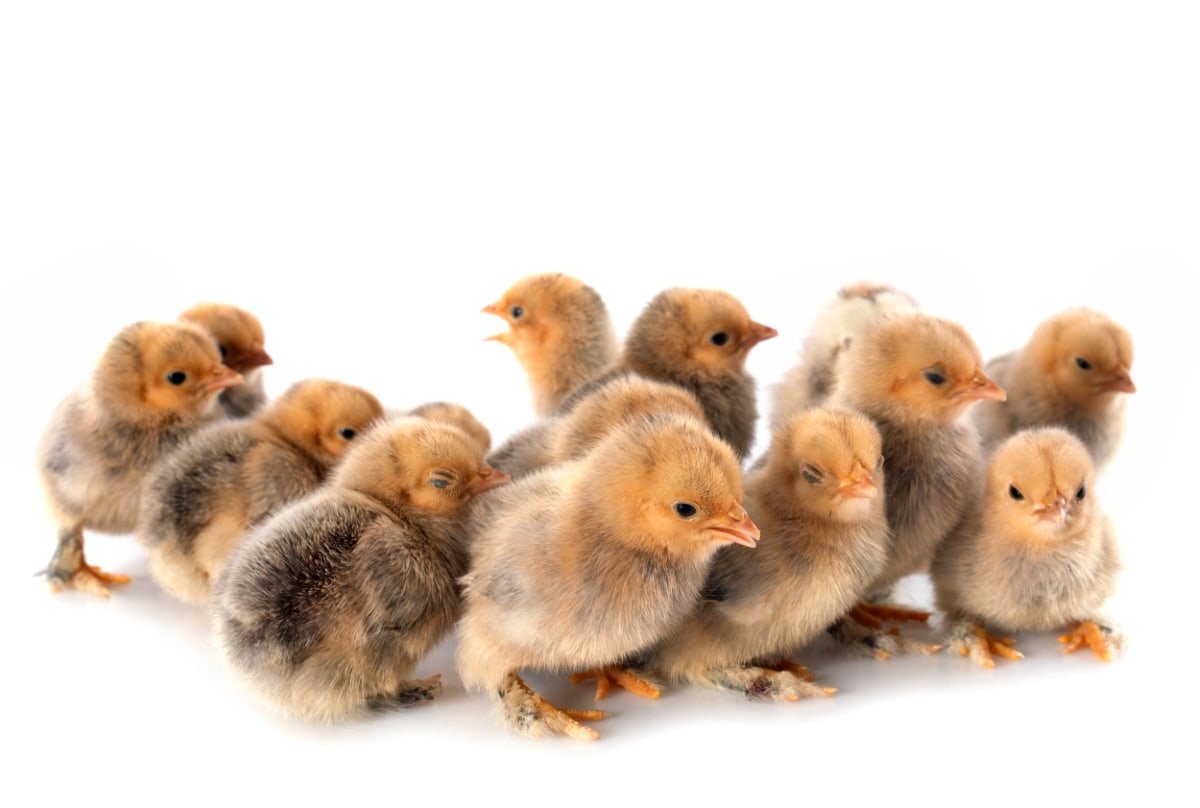The first two months of raising baby chicks are crucial for their health and development. During this time, you’ll provide them with warmth, nourishment, and care as they grow from fluffy chicks to lively young chickens. In this baby chick care guide, we’ll walk you through the essential steps and considerations for the first 60 days chick care of raising baby chicks, from day one to the exciting chick growth milestones ahead.

How to Raise Baby Chicks
Day 1: Arrival and Setup
Setting Up the Brooder
Begin by preparing a brooder setup for chicks, a warm enclosure that mimics the nurturing conditions of a mother hen. Line the bottom with absorbent bedding like pine shavings, providing insulation and traction for their tiny feet. Ensure the brooder is spacious enough for their growth yet cozy enough to retain warmth.
First Feed and Water
Upon arrival, introduce your chicks to their first meal and drink. Offer a high-quality chick starter feed specifically formulated to meet their nutritional needs for healthy growth. Provide fresh, clean water in shallow containers designed to prevent drowning.
How to feed baby chicks? Dip their beaks gently into the water to encourage drinking.
Days 2-7: Monitoring and Care
Temperature Checks
Continuously monitor the temperature for baby chicks in the brooder to ensure it remains within the appropriate range for their age. Use a thermometer placed at chick level to gauge the ambient temperature for baby chicks accurately. Install a heat lamp or heat source, maintaining a temperature of around 35°C for the first week, gradually decreasing by three °C each week until they’re fully feathered.
Health Observations
For keeping baby chicks healthy, regularly observe your baby chicks for any signs of illness or distress. Look for indicators such as lethargy, huddling together excessively, abnormal droppings, or unusual behaviors. Check their vent area for signs of pasting, a condition where droppings stick to the chick’s vent, potentially causing blockages and discomfort. Ensure their eyes are bright and clear, with no signs of discharge or swelling.
Week 2: Diet and Environment
Feeding Routine
Establish a feeding routine to ensure your chicks receive adequate nutrition for optimal baby chicken development. Continue offering a high-quality chick starter feed, accessible at all times. Supplement their diet with small treats such as finely chopped greens or mealworms to encourage foraging behavior and provide additional nutrients. Monitor their feeding behavior closely, adjusting the quantity of feed as needed. Clean their feeders regularly to maintain hygiene and prevent contamination.
Brooder Maintenance
Baby chick brooder maintenance involves removing soiled bedding and droppings daily to prevent ammonia buildup and minimize odors. Refresh the bedding as needed to maintain cleanliness and absorbency. Inspect the brooder for any signs of wear or damage, repairing or replacing any compromised components promptly. Ensure adequate ventilation to promote air circulation and reduce humidity levels.
Week 3: Growth and Development
Space Adjustments
With their increasing size and activity levels, your chicks will require more space to move around comfortably. Expand the area of their brooder or provide access to a larger enclosure to promote healthy exercise and prevent overcrowding. Ensure sufficient space for all chicks to spread their wings and explore without feeling cramped. Consider introducing perches or platforms to encourage natural behaviors like roosting and hopping.
Feather Monitoring
During week 3, your chicks’ downy fluff will gradually be replaced by primary feathers. Monitor their feather development closely, observing the emergence of wing feathers and tail feathers. Healthy feather growth is indicative of proper nutrition and environmental conditions. Keep an eye out for any abnormalities or signs of feather picking, which may indicate stress or health issues.
In case you missed it: Ultimate Guide to American Game Chicken: Explore Breed Profile to Diet and Care

Week 4: Socialization
Handling Time
Regular baby chick handling and socialization are essential for socializing your chicks and building trust. Set aside time each day for handling sessions, allowing your chicks to become accustomed to human contact. Approach them calmly and confidently, supporting their bodies securely while speaking in a soothing tone.
Introducing New Foods
Offer treats such as finely chopped fruits, vegetables, and herbs to encourage exploration and provide additional nutrients. Introduce new foods gradually, starting with small portions and monitoring their response. Avoid offering foods with high in salt, sugar, or processed ingredients, opting instead for fresh, natural options.
Weeks 5-6: Preparing for Transition
Outdoor Time
Start with short supervised outings in a secure, enclosed area free from predators. Allow them to explore grassy areas, peck at the ground, and bask in natural sunlight. Monitor their behavior closely, ensuring they remain safe and protected from potential hazards. As they grow more accustomed to outdoor environments, gradually extend the duration of outdoor time for baby chicks to promote physical activity and mental stimulation.
Coop Preparation
Prepare their permanent living space by completing the setup of their coop or chicken run. Ensure the coop is predator-proof, with secure latches on doors and windows and sturdy fencing around the perimeter. Provide ample roosting space and nesting boxes filled with clean bedding for comfort and warmth. Install feeders and waterers in accessible locations, protected from the elements and potential contamination.
Weeks 7-8: Health and Wellness
Health Checks
Inspect their eyes, beak, comb, and vent for any abnormalities or signs of infection. Monitor their behavior and appetite, noting any changes in activity level or feeding patterns. Check for external parasites like mites or lice, especially under the wings. Keep their living environment clean and sanitary to prevent illness in chicks.
Vaccination Decisions
Consult with a poultry veterinarian or local agricultural extension office to determine the recommended baby chick vaccination guide and options for your flock. Common vaccines for chicks include those for Marek’s disease, infectious bronchitis, and Newcastle disease. Make informed decisions regarding vaccination to protect your chicks from preventable diseases and ensure their long-term health and well-being.
Week 9: Gradual Transition
Acclimatizing to Coop Life
Encourage your chicks to acclimate to their coop environment by gradually increasing their time spent indoors. Allow them to explore the coop during the day, returning them to the brooder or a secure area at night. Provide plenty of perches and roosting space for them to settle comfortably. Monitor their behavior closely, ensuring they adapt well to their new surroundings and flock dynamics for transitioning chicks to coop successfully.
Feed Transition
Gradually transition your chicks to a grower or starter-grower feed formulated for older chickens. Introduce the new feed gradually over several days, mixing it with their existing feed to ease the transition. Monitor their consumption and adjust the ratio of old to new feed as needed. As one of the essential supplies for baby chicks, ensure they have access to clean, fresh water always to aid digestion and prevent dehydration.
Weeks 10-12: Integration and Independence
Full-Time Coop Living
Remove any remaining supplemental heat sources from the coop, as their feathers should provide sufficient insulation against cooler temperatures. Monitor their behavior closely, ensuring they roost comfortably at night and exhibit normal flock behaviors during the day. Provide enrichments such as dust baths, perches, and toys to promote mental stimulation and physical activity.
In case you missed it: Ultimate Guide to Iowa Blue Chicken: Discover from Breed Profile to Diet and Care

Monitoring Integration
Monitor for any signs of bullying or pecking order disputes, intervening as necessary to prevent injury or stress. Provide multiple feeders and waterers to reduce competition and ensure all chickens have access to essential resources. Consider integrating chicks with flock strategies such as distraction feeding or rearranging coop furnishings to mitigate conflict and promote harmonious flock dynamics.
Ongoing Care Beyond Day 60
Regular Health Checks
Perform routine health checks on your chickens to monitor for signs of illness, injury, or parasites. Inspect their feathers, skin, eyes, and vent for any abnormalities or signs of distress. Monitor their weight and behavior, noting any changes in appetite, activity level, or social interaction. Address any health concerns and signs of stress in baby chicks promptly by consulting with a poultry veterinarian and implementing appropriate treatment measures.
Nutritional Adjustments
Adjust your chickens’ diet as needed to accommodate their changing nutritional requirements. Transition them to a layer feed formulated specifically for laying hens once they reach maturity, typically around 18-20 weeks of age. Provide supplemental calcium sources such as crushed oyster shells to support eggshell formation and prevent calcium deficiencies.
In case you missed it: Ultimate Guide to Buckeye Chicken: Discover from Raising Facts to Breed Profile

Conclusion
Raising baby chicks during their first two months is a rewarding journey that needs dedication and attention to detail. By following these guidelines and remaining vigilant in care, you’ll lay a strong foundation for healthy, thriving chickens. Here’s to many happy years of poultry keeping ahead!
- Feed Your Flock for Less: Top 10 Tips to Save on Chicken Feed
- Ultimate Guide to Ossabaw Island Hog: Breeding, Raising, Diet, and Care
- Hatching Answers: The Top 10 Reasons Your Chickens Aren’t Laying Eggs
- Eggs and Economics: Breaking Down the Cost of Raising Backyard Chickens
- Defend Your Greens: Proven Methods to Keep Iguanas Out of Your Garden
- Ultimate Guide to Cinnamon Queen Chicken: A Comprehensive Guide for Beginners
- Ultimate Guide to California Tan Chicken: Breeding, Raising, Diet, Egg-Production and Care
- Ultimate Guide to Marsh Daisy Chicken: Breeding, Raising, Diet, and Care
- 10 Types of Chicken Farming Businesses You Can Start for Profits